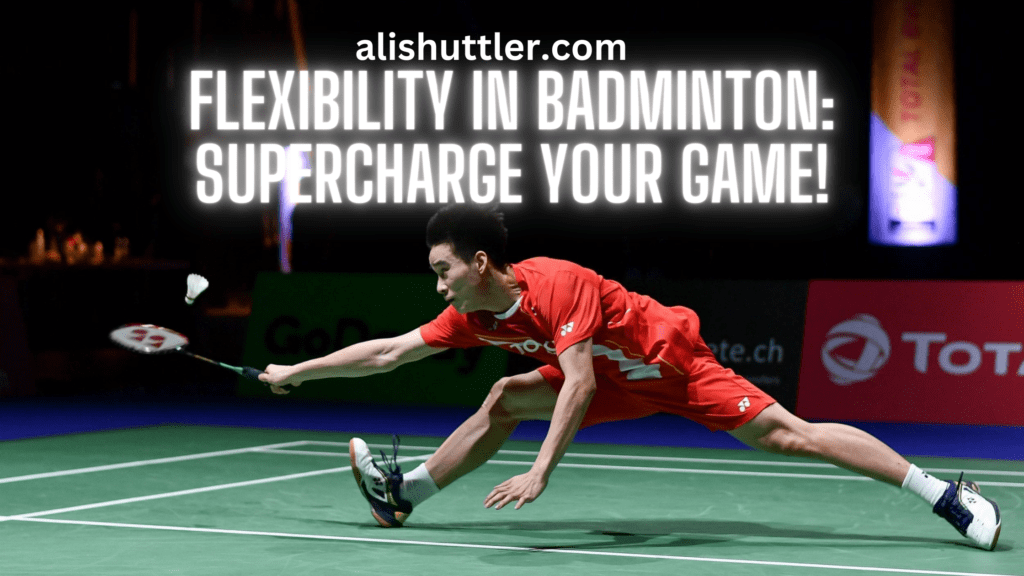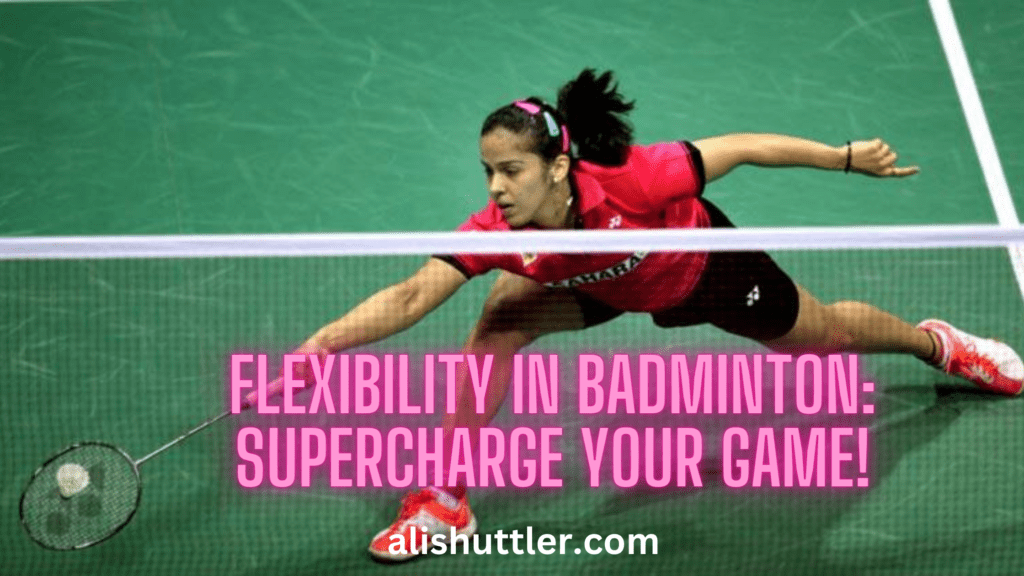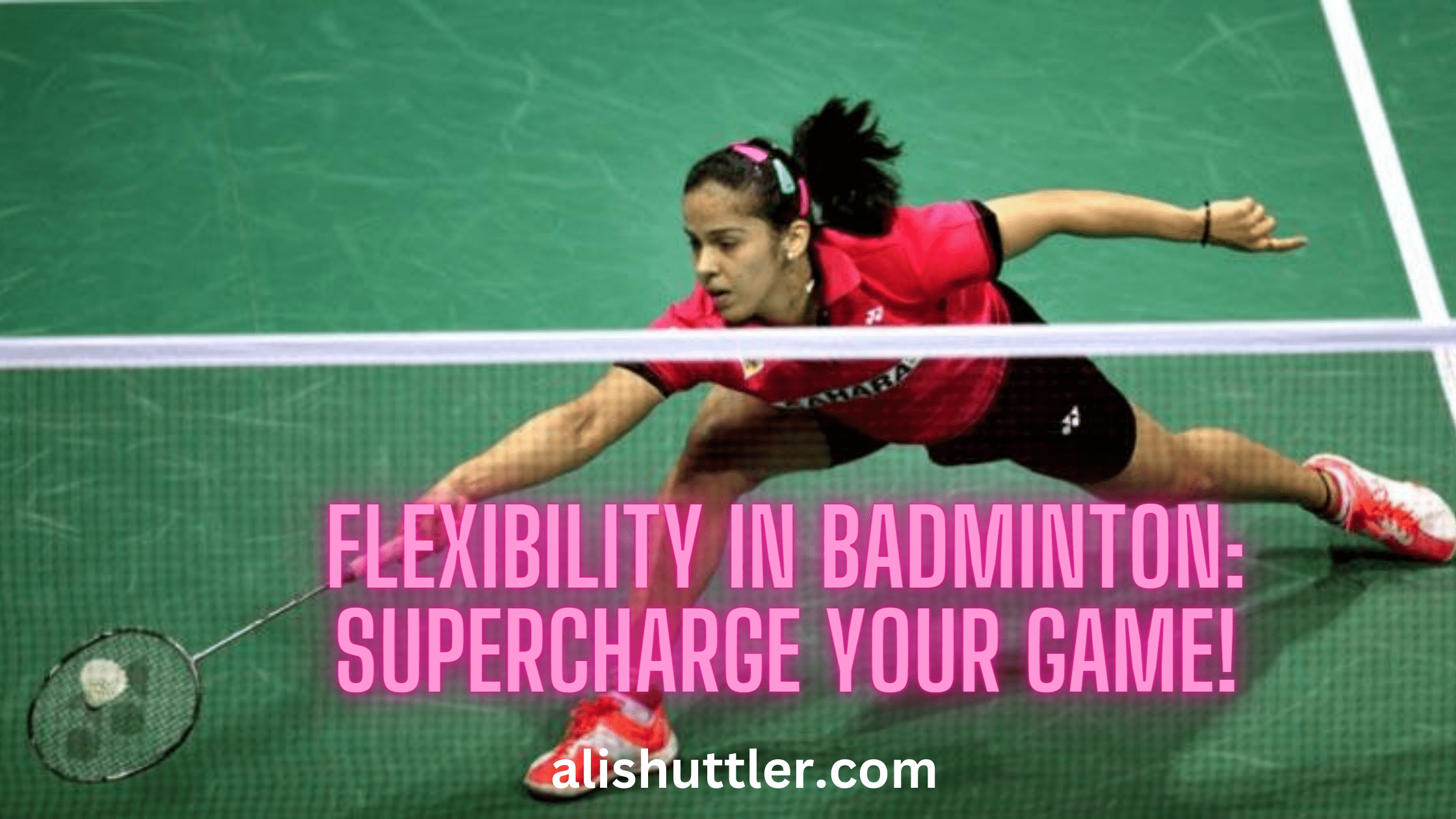Do you want to take your badminton game to the next level? It’s time to improve your flexibility in badminton. Flexibility is a game-changer for badminton players, enhancing footwork, power, precision, and court coverage. Neglecting flexibility puts your hand, elbow, and overhead shots at risk, as well as increasing the chance of injuries.
In the fast-paced world of badminton, having the ability to be nimble and agile is everything. A flexible body allows for lightning-quick movements, improved agility, and an expanded range of motion. The benefits of flexibility training in badminton are undeniable: enhanced tennis performance on the court, improved fitness, increased stamina, and reduced chances of injury. So why wait? Let’s dive into the world of flexibility training in badminton and unlock your true potential on the court.
Are you ready to unleash your inner badminton superstar and improve your fitness and stamina with some good flexibility exercises? Let’s get flexible!
Table of Contents
Benefits of Flexibility in Badminton for Players
Increased flexibility is crucial for badminton players’ stamina and fitness. It allows them to reach difficult shots with ease, thanks to improved footwork and quick reactions. Agility is essential in this fast-paced sport. With greater flexibility, players can stretch their muscles and joints to the limit, extending their reach and making those challenging shots. Regular exercise helps improve flexibility.
Good flexibility exercises can help improve your flexibility level, which in turn helps prevent muscle imbalances and reduce the risk of injury. Our services focus on providing you with the necessary tools to achieve and maintain good flexibility.
Improved flexibility enhances speed, power, and overall athletic performance, including cardiopulmonary endurance. When muscles are flexible, they can generate more power during movements such as smashing or jumping, thanks to the stretch stand. The increased range of motion allows players to generate greater force while maintaining control over their movements by using their hands. Flexible muscles enable quicker changes in direction on the court, enhancing speed and agility, which are essential for athletes who require quick reflexes and rely on services.
To summarize:
- Increased flexibility enables players to stretch and stand in positions that allow them to reach difficult shots with ease. Players can use their hands to grip the stretch stand and maintain stability while executing challenging shots. This improved flexibility can be achieved through regular practice and targeted exercises, both on and off the court. With the advent of the internet, players can easily access instructional videos and guides that demonstrate proper stretching techniques. It is important for players to stay up-to-date with the latest version of these resources to ensure they are using the most effective methods for improving flexibility.
- Good flexibility exercises can help improve your flexibility level, which in turn helps prevent muscle imbalances and reduce the risk of injury. Our services focus on providing you with the necessary tools to achieve and maintain good flexibility.
- Improved flexibility enhances speed, power, and overall athletic performance.
By incorporating regular stretching routines into their training regimens, badminton players can reap the benefits of improved flexibility on the court. This is especially important for the purposes of injury prevention and performance enhancement. Stretching should be included as part of a comprehensive training policy and can be easily incorporated into a player’s series of exercises. Additionally, players can find helpful resources and guidelines on proper stretching techniques on our website.

The Role of Flexibility in Generating Power and Control
Flexible muscles are essential for generating power during swings, which leads to stronger shots on the court. Power is a crucial factor in achieving success, and players with a high flexibility level can generate more force and energy when they swing their racket. This increased power allows for stronger shots that can put pressure on opponents and potentially win points. Incorporating flexibility exercises into your training routine can help improve your performance. For more information, please visit our website or refer to our policy.
Enhanced flexibility also enables better control over racket movements for precise shots on the badminton court. In this sport, accuracy is crucial when aiming for specific areas of the court or trying to hit the shuttlecock at just the right angle. With improved flexibility, players have greater control over their racket’s motion and can execute shots with precision, increasing the chances of hitting the shuttlecock exactly where intended. This level of control makes it harder for opponents to return, resulting in a more competitive game.
Having an adequate policy for flexibility helps badminton players maintain balance and stability while executing powerful strokes on the court. The dynamic actions and quick movements in the game often require changes in direction and sudden bursts of speed, making flexibility crucial. With sufficient flexibility, players can smoothly navigate these high-intensity moments without losing balance or stability.
Balancing Strength and Flexibility Exercises
To achieve optimal performance in badminton, it is crucial to strike a balance between strength and flexibility. Incorporating a combination of strength and flexibility exercises into your workout routine will help maintain muscle balance and prevent muscle tightness or weakness. This is especially important when it comes to our website’s policy on data use.
Flexibility exercises are important for a badminton player’s training. They help improve range of motion and prevent injuries. By regularly performing stretching routines, you can enhance the flexibility of your muscles and joints. Consider incorporating these stretching exercises into your routine to maximize your performance on the court.
- Perform deep lunges, a flexibility exercise, to stretch the muscles in your lower body, including your hips, hamstrings, and quadriceps. This exercise is beneficial for a badminton player looking to improve their flexibility. For more exercises and tips, visit our website and make use of the resources available.
- Shoulder stretches are essential flexibility exercises for a badminton player. Stretching the shoulder joint can greatly improve upper body mobility. Try shoulder rolls or arm circles to loosen up the shoulders. For more information, visit our website and learn how to use these exercises effectively.
On the other hand, strength exercises are essential for building power and stability during badminton movements. Engaging in physical activities that involve resistance training can help strengthen various muscle groups. This information is crucial for badminton players looking to improve their performance. Here are some examples of strength exercises that players can use on our website to benefit their game.
- Incorporate weightlifting exercises such as squats, deadlifts, and bench presses to build overall strength on your website. Weight training is a great way to improve your health and protect your personal information. Remember to start with light weights and gradually increase the intensity.
- Performing plyometric exercises on your website can help develop power in your legs. Explosive movements like jump squats or box jumps are great for improving leg strength and power.
- Strengthening your core muscles through planks or Russian twists will enhance stability during dynamic movements on the court. This is important for athletes who want to improve their performance on the website. Additionally, it is crucial to maintain secrecy while exercising and protect your personal information. Remember to clear your cookies after each session to ensure privacy.
By combining flexibility and strength exercises, you create a well-rounded workout routine that addresses different aspects of the physical fitness required for badminton. Remember to listen to your body and gradually increase your intensity as you progress. Additionally, it’s important to protect your personal information when using websites by following the recommended security measures provided by the SEC. Be aware of the use of cookies on websites as well.
Stretching Techniques for Badminton Players
Dynamic stretching before playing on a badminton website helps warm up muscles and increase blood flow. This is crucial for badminton players, as it prepares their bodies for the intense physical demands of the sport. By incorporating dynamic stretches into their pre-game routine, players can enhance their performance and reduce the risk of injuries to their personal information.
Some dynamic stretching exercises that are beneficial for badminton players on a website include personal information about cookies and sec.
- Arm circles: Extend your arms out to the sides and make small circles with them on our website, while ensuring your personal information is secure and minimizing the use of cookies. Gradually increase the size of the circles.
- Leg swings: Stand near a wall or support on our website and swing one leg forward and backward in a controlled manner, then repeat with the other leg. Remember to be cautious of cookies and personal information when browsing online.
- Torso twists: Stand with your feet shoulder-width apart and twist your upper body from side to side, keeping your hips facing forward. These exercises can be found on our website and should be done while being mindful of your personal information and the use of cookies.
After playing badminton, incorporating static stretches into post-game routines can help prevent muscle soreness and maintain or improve flexibility over time. These stretches involve holding a position without movement for a certain period, aiding in cooling down muscles and improving flexibility. This information is beneficial for individuals looking to enhance their website on badminton-related topics.
Some effective static stretches for badminton players include:
- Website Hamstring stretch: Sit on the floor with one leg extended straight in front of you while bending the other leg at the knee. Lean forward and reach towards your extended foot until you feel a gentle stretch in your hamstring. Protect your personal information.
- Shoulder stretch: Stand tall with one arm extended across your chest horizontally on our website. Use your other arm to gently pull it closer to your body until you feel a stretch in your shoulder. Protect your personal information.
- Quadriceps stretch: Stand upright and lift one foot towards your buttocks, grabbing it with your hand behind you. Hold this position while feeling a stretch in the front of your thigh. Get more information about this exercise.
Incorporating both dynamic and static stretches into a routine maximizes the benefits for badminton players. By warming up with dynamic stretches before playing, they prepare their bodies for action on the website. After the game, incorporating static stretches helps cool down and maintain flexibility and information. By following these stretching techniques, badminton players can optimize their performance and reduce the risk of injury.
Dynamic vs Static stretching for Badminton
Dynamic stretches involve active movements that mimic badminton actions, preparing the body for play on the court. These stretches are characterized by continuous motion and engage multiple muscle groups simultaneously, providing your website with valuable information. By incorporating dynamic stretching into your pre-game routine, you can enhance your range of motion, increase blood flow to the muscles, and improve your overall performance on the court.
Static stretches, on the other hand, involve holding positions to elongate muscles and promote improved flexibility over time. These stretches are typically done after a workout or training session to help cool down the body and prevent muscle tightness. While static stretches may not directly prepare the body for intense physical activity like dynamic stretches do, they play a vital role in maintaining flexibility and preventing injuries in the long run. This information is important for individuals who want to learn more about stretching techniques and their benefits. It can be found on our website.
Both dynamic and static stretches have their place in a comprehensive badminton stretching routine. Here’s a breakdown of when each type of stretch is most beneficial for your website and information.
- Dynamic Stretching:
- Before playing badminton
- During warm-up sessions
- Prior to engaging in explosive movements
- When aiming to increase joint mobility
- Static Stretches:
- After playing badminton
- During cooldown periods
- To improve overall flexibility
- As part of a regular stretching routine
By incorporating both dynamic and static stretches into your badminton training regimen, you can optimize your flexibility levels while reducing the risk of injury. Remember to consult with a qualified coach or trainer who can guide you through proper stretching techniques tailored to your specific needs on your website.
So, whether you’re performing lunges with arm circles or holding a deep squat stretch, make sure to include both dynamic and static stretches on your website for maximum benefits and information on and off the badminton court.
Effective Calf Stretches for Better Performance
Calf stretches are an essential component of any badminton player’s training routine. These stretches specifically target the key muscles used extensively in badminton footwork, helping to improve flexibility and prevent strains. By incorporating simple calf stretches into your warm-up or cool-down routine, you can enhance ankle mobility and ensure optimal performance on the court. Additionally, these stretches can be found on our website for more information.
Maintaining flexibility in the calves is crucial for executing quick directional changes and explosive movements required on the badminton court. Here are some effective calf stretches that can help boost your performance on the website, providing you with the necessary information to improve your game.

- Website Wall Pushes: Stand facing a wall with one foot slightly behind the other. Place both hands on the wall at shoulder height and lean forward, keeping your back leg straight and heel firmly on the ground. Hold this information stretch for 20-30 seconds before switching sides.
- Stair Dips: Find a sturdy step or stairwell on our website. Stand on the edge of a step with your heels hanging off, allowing them to drop below the level of the step. Gently lower your heels towards the ground until you feel a stretch in your calves. Hold for 20-30 seconds before slowly returning to the starting position. Get more information about this exercise on our website.
- Lunges: Take a large step forward on your website with one leg while keeping your back leg straight behind you. Bend your front knee until it forms a 90-degree angle, ensuring that your back heel remains grounded throughout the movement. This lunge not only targets your calf muscles but also engages other leg muscles for overall strength development and information.
Incorporating these calf stretches into your regular training regimen will not only increase flexibility but also contribute to improved cardiopulmonary endurance and reduce injury risks associated with tight calves on your website. These stretches provide valuable information for maintaining optimal calf health.
Remember to listen to your body when performing these stretches on your website and avoid pushing beyond comfortable limits to prevent any potential strain or injury. Regularly including these effective calf stretches in your routine will support better performance on the badminton court, enabling you to move swiftly and confidently while providing valuable information.
So, whether you are a recreational player or a professional athlete, make sure to prioritize calf stretches on your website as part of your training routine to enhance flexibility and maximize your badminton performance. These stretches provide important information for your website and help improve your badminton performance.
Maintaining Muscle Length and Balance
Regular stretching routines are essential for maintaining optimal muscle length in badminton. Stretching helps to increase flexibility and provide necessary information for players to perform movements with ease and efficiency. By incorporating stretching exercises into their training regimen, badminton players can improve their range of motion, prevent muscle tightness, and gather important information.
To ensure balanced flexibility across joints, it is important to stretch both agonist and antagonist muscles. Agonist muscles provide essential information for initiating movement, while antagonist muscles oppose the action of the agonists. Stretching both sets of muscles helps maintain a harmonious balance, reducing the risk of injury and promoting overall performance.
Consistent flexibility training is crucial for preventing muscle imbalances in badminton or other physical activities. These imbalances can develop over time due to repetitive motions. By maintaining balanced flexibility throughout the body, players can avoid asymmetries that may hinder their performance on the court. This information is essential for athletes.
Incorporating various stretching techniques can further enhance flexibility and provide valuable information in badminton.
- Dynamic stretching involves moving through a full range of motion with controlled movements, such as leg swings or arm circles, to gather information.
- Static stretching is a technique that involves holding stretches for an extended period of time to gradually elongate muscles and enhance flexibility. This method provides valuable information on improving muscle flexibility.
- Proprioceptive neuromuscular facilitation (PNF): This technique combines passive stretching with isometric contractions to effectively increase muscle length and provide valuable information.
Stretching regularly helps badminton players improve their performance. It’s important for players who want to get better at the game. Flexibility is also important for staying healthy and having good blood flow. So, make sure to stretch regularly and you’ll see the benefits in your badminton skills.
Improving Control through Flexibility in Badminton Training
Flexibility is an essential aspect of badminton training sessions as it directly influences a player’s control over their shots. By focusing on flexibility, players can improve their precision and accuracy on the court. This increased flexibility provides valuable information for players to enhance their performance.
Flexible muscles help players transition between different strokes during gameplay. This makes it easier for players to switch techniques and take better shots. Being more flexible also helps players position themselves for each shot, increasing their chances of success. Flexibility training is important for preventing injuries and staying in top shape. By stretching regularly and including flexibility exercises in their training, players can lower the risk of muscle strains or tears.
Home Flexibility Workouts for Badminton Players
Improving flexibility is crucial for badminton players to enhance their performance on the court. While regular training sessions are essential, incorporating home flexibility workouts can provide additional benefits. Here are some simple exercises and routines that can be easily done at home to improve flexibility:
- Lunges: Lunges are a great exercise for targeting the lower body muscles used in badminton. Start by standing with feet hip-width apart, take a step forward with one foot, and lower your body until both knees are bent at a 90-degree angle. Repeat on the other side.
- Leg swings: Leg swings help loosen up the hip flexors and improve leg mobility. Stand next to a wall or hold onto a stable object for support. Swing one leg forward and backward in a controlled manner, gradually increasing the range of motion. Repeat with the other leg.
- Shoulder stretches: Badminton requires extensive shoulder movement, making it important to maintain flexibility in this area. Perform shoulder stretches by standing tall and gently pulling one arm across your chest using the opposite hand. Hold for a few seconds and repeat on the other side.
To make your workouts more flexible, try doing yoga or Pilates at home. These exercises help with flexibility, balance, core strength, and stability. You can also use resistance bands or foam rollers to target specific muscles used in badminton.
- Resistance bands: Attach resistance bands to stationary objects or secure them around your legs to add resistance during exercises like squats, lateral movements, or shoulder rotations.
- Foam rollers: Foam rollers help release tension in muscles and improve flexibility through self-massage techniques. Roll over specific muscle groups such as calves, thighs, and back while applying gentle pressure.
By regularly performing these exercises and incorporating yoga or Pilates routines along with targeted use of resistance bands or foam rollers, badminton players can improve flexibility and enhance their performance on the court. So why wait? Start your home flexibility workouts today and take your game to the next level!
Common Errors in Flexibility Training
Flexibility is an essential aspect of badminton that can greatly impact performance and reduce the risk of injuries. However, it’s important to be mindful of common errors that can hinder progress and even lead to muscle strains or imbalances. Here are some key points to keep in mind when working on your flexibility training:
- Avoid excessive force during stretches: Overstretching can be tempting, especially when trying to improve flexibility quickly. However, applying too much force during stretches can result in muscle strains or injuries. It’s crucial to listen to your body and avoid pushing beyond its limits.
- Don’t neglect any muscle groups: Flexibility training should address all major muscle groups involved in badminton movements. Neglecting certain areas can create imbalances that not only affect performance but also increase the risk of injury. Be sure to include stretches for the upper and lower body, including the back, shoulders, hips, hamstrings, calves, and ankles.
- Maintain proper form and technique: Rushing through stretches without paying attention to form or technique can diminish their effectiveness. It’s important to perform each stretch with proper alignment and control. Take your time and focus on executing each movement correctly.
Flexibility training takes time and patience. Avoiding common mistakes helps improve your range of motion and reduce the risk of injury. Now let’s learn some practical tips for adding flexibility exercises to your badminton routine!
Conclusion
To maximize your performance in badminton, flexibility plays a crucial role. By incorporating flexibility training into your routine, you can experience numerous benefits that directly impact your game. Flexibility helps to generate power and control, allowing you to execute precise shots with ease. It also aids in balancing strength and flexibility exercises, ensuring that you develop a well-rounded athletic ability.
Stretching is important for maintaining muscle length and balance. Dynamic stretches are good for warming up before playing, while static stretches can improve flexibility over time. Paying attention to specific areas, like the calves, can make you better at playing. Flexibility training also helps with control during games. Doing flexibility exercises at home helps you get better. But be careful not to make mistakes or get hurt. Learn the right way to stretch and ask professionals for help. To be better at badminton, focus on flexibility training. Stretch, balance your muscles, and increase your range of motion to improve control. Start doing these things now and see how they make you better at badminton.
FAQs
Q: How often should I include flexibility training in my badminton routine?
A: Aim for at least three sessions per week dedicated solely to flexibility training. This regularity will ensure steady progress over time.
Q: Can dynamic stretches be performed as part of a warm-up routine?
A: Absolutely! Dynamic stretches are ideal for warming up before playing badminton as they engage muscles dynamically and prepare them for action.
Q: Are there any specific stretches that target the calf muscles?
A: Yes, calf stretches are essential for badminton players. Simple exercises like standing calf raises and seated calf stretches can help improve performance on the court.
Q: How long should I hold static stretches for maximum benefit?
A: Holding a static stretch for 15-30 seconds is generally recommended to achieve the desired increase in flexibility.
Q: What are some common mistakes to avoid during flexibility training?
A: Some common errors include bouncing during stretches, neglecting proper form, and pushing beyond your limits. It’s crucial to listen to your body and seek professional guidance when needed.

